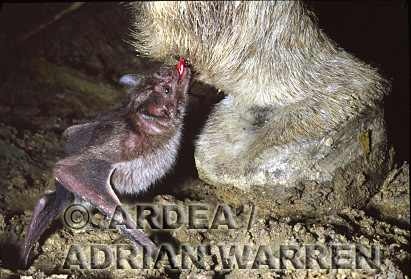
Vampire Bat
Desmodus rotundus
Myths and legends from all over the world portray bats as blood-sucking demons. Vampire bats really do exist, but only three species in Central and South America.

The vampire bats (Desmodus rotundus) have a wingspan of about eight inches and a body about the size of an adult's thumb. If not for their diet, people would not pay much attention to these small bats. Vampire bats feed on the blood of large birds, cattle, horses, and pigs. However, they donŐt suck the blood of their "victims".

Using their sharp teeth, the bats make tiny cuts in the skin of a sleeping animal. The bats' saliva contains a chemical that keeps the blood from clotting. The bats then lap up the blood that oozes from the wound. Another chemical in their saliva numbs the animal's skin and keeps them from waking up.

A vampire bat finds its prey with echolocation, smell, and sound. They fly about one meter above the ground. Then they use special heat sensors in their noses to find veins that are close to the skin.
Scientists have discovered that vampire bat saliva is better at keeping blood from clotting than any known medicine. Vampire bats may one day help prevent heart attacks and strokes. Vampire bats are one of the few bat species that are considered a pest. In Latin America, cattle raising is a growing business, and sleeping cattle attract vampire bats. In ranching areas, control programs have been started. However, millions of beneficial bats are destroyed by people who mistake them for vampires.

| 
